(Or first impressions this century: I once feared Tracy and the whole San Joaquin Valley as a hitchhiker’s no man’s land in my ride-thumbing college years, have yet to forget an eleven hour wait for a ride in North Fresno.)
Tracy is a city of about 87,000 in the agricultural flatlands east of San Francisco. I am in temporary digs here while awaiting paperwork for a move to Spain1, naively anticipated a rural whistlestop far removed from Bay Area bustle.
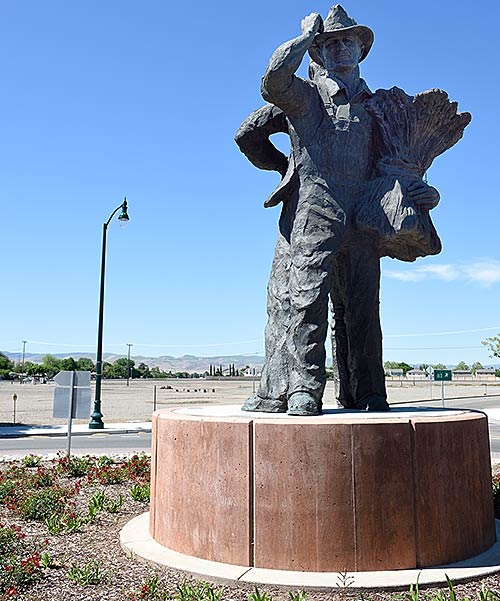
Wrong! In the 1970s, maybe. Not anymore.
TRACY MAY SOON BE DEVOURED BY THE GREATER BAY AREA
Travel out this-a-way and you’ll see what I mean. The driver exiting the easternmost Livermore fringes of the “San Francisco Bay Area” at noon can expect all of fifteen minutes of open country on the Altamont Pass before hitting outer Tracy of “Central California” at 12:15. That’s not much of a greenbelt between regions.
I hatched an informal survey question — Has Tracy become part of the Greater Bay Area? — and posed it to about a dozen locals. Votes have leaned about 2 to 1 “no” … but not 10 to 1, as I might have expected in years past.
My favorite response came while querying two fellow congregants at the Stockton Unitarian Church. One nodded, said, “Oh, it’s getting there,” but was refuted with an emphatic “No!” from an usher.
The usher explained: Tracy has attracted many settlers who want it to be part of the Bay Area, said she. They buy in, discover that they can’t endure the marathon freeway commute, sell out a few years later.
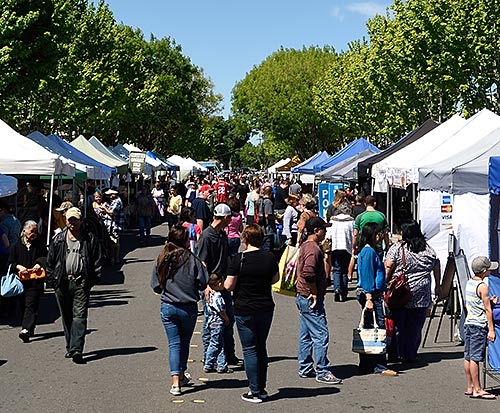
Another local introduced an acronym: BAT, for Bay Area Transplant. Letters-to-the-editor writers fulminated often about BATs in years past, but gave up as more BATs moved in, became neighbors.
The BATs likely came for affordable homes. I drive past a freeway billboard hawking new construction, look it up online. 4 bedrooms, 3 baths, American Dream houses: around $200 a square foot, vs $987 in San Francisco, $475 in Walnut Creek. At a picnic in Micke Grove Park, I meet a Bay Area widow who had to short sell after her husband’s death, and chose an all-cash, debt-free buy in Central California instead of a mortgage elsewhere. A retired Santa Clara native marvels at the empty acres behind his Stockton property. The picnic host fled San Jose after a steep rent increase.
I shop at vast, concrete-acred WinCo Foods, stroll among a pleasant cultural mélange: a linebacker-shouldered blond in John Deere t-shirt, lugging six packs to a big-tired pick-up; a turbaned Sikh and clan; occasional hijabs; a likely Berkeley refugee, rummaging for credit card in a tote with Feel the Bern button; many, many families.
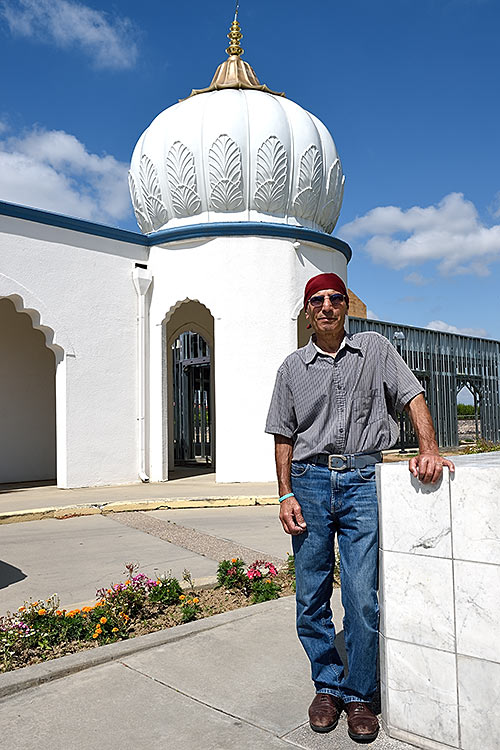
Absent, however: the overtly gay, and some extravagances of youthful fashion that are commonplace on Valencia Street. BATs may have diluted Tracy’s rural roots, but still take a low profile here.
TRACY IS CAR COUNTRY
My digs are near Naglee and Pavilion Parkway, which intersect acres for four surrealistically vast mall properties on Tracy’s northwest corner.
I’ll link a map. Mouse around a bit.
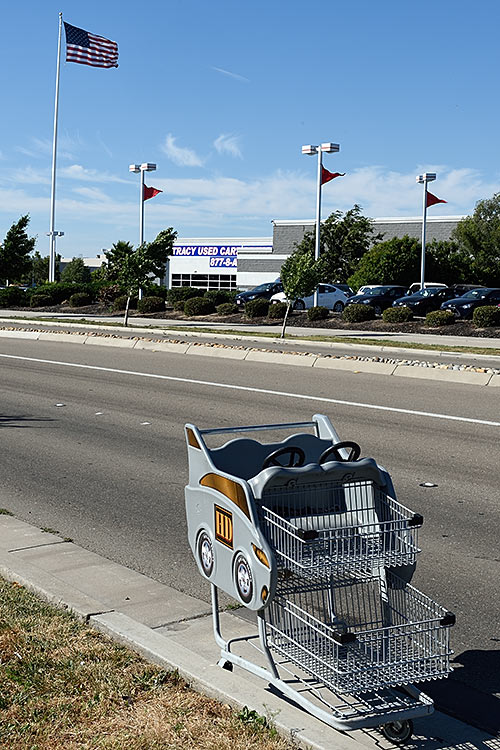
Home Depot is here, as are Staples, Macy’s, many car dealerships. Target is here, too, but looks like a pint-sized mom n’ pop next to the Walmart. Fate may have decreed that I spend my last weeks on native soil amidst development most often stereotyped as American. I take a spring afternoon stroll on asphalt, across adjoining parking lots, with gas stations and big box stores on the horizon, beneath the rippling stripes of American flags.
Everyone drives here. Even the Starbucks offers a drive-thru lane for profligately idling SUVs. The nearest BART metro station is twenty-five miles west, and internet wags promise wailing and gnashing of teeth to weekday commuters who hope to park there.
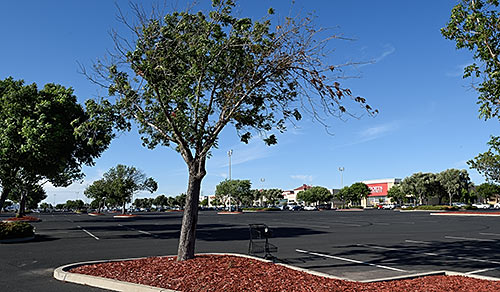
This corner of Tracy is much more autocentric than older city neighborhoods, but I still can’t imagine any serious getting around by transit. I may have driven more in a month here than in several years in San Francisco.
TRACY IS OVERWEIGHT
Is this observation related to the first two? Who wants to cook or hit a Pilates mat after dodging SUVs and semis on the daily slog home from Hayward, or Walnut Creek, or wherever the steering-wheel-clutching BAT punches a timecard? One is T-I-R-E-D. Lane changes on the 580 were work-out enough. Quick energy comfort food is what one craves, easily obtained from stuffins’-drippin’ megaburgers with four figure calorie counts hawked by fast fooderies next to the 205. Gorge now, worry about the scale tomorrow. A BAT might get all of an hour of rec time before hitting the sack for the next day’s commute.
I want to write charitably, with sympathy. I was overweight in my teens. I have stood pat at 175 for ten years because my last real diet was so miserable that I swore afterward never to slide again, and haven’t. But those miseries were endured to lose a mere fifteen pounds! Some I see on my mall strolls are more than a hundred pounds overweight. Their bodies heartlessly conspire to hold onto every ounce, to doom them to obesity until death.
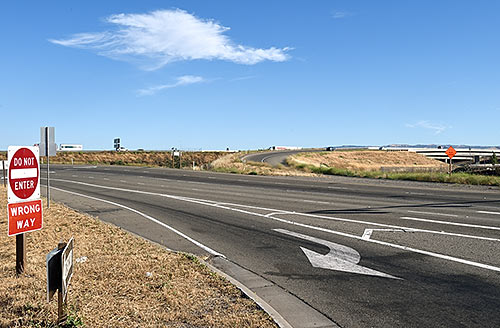
Many in Tracy may be obese because they aren’t BATs, because they are the great-grandchildren of farmers who once sweated over tractors and tills, and could expect to burn through any calories consumed. I don’t know. I imagine the ghost of Lathrop J. Tracy himself grimacing at the sight of his town’s overfed progeny, courting diabetes, atherosclerosis, osteoarthritis as they lumber with overtaxed hearts on outraged joints through pastry aisles. Their bodies are like prisons.
HAS BAY AREA INFRASTRUCTURE PLANNING FAILED?
My S.F.-to-Tracy car trips have fostered a bleaker take on the Bay Area’s transportation underpinnings. It feels like a catastrophic fait accompli: bad enough to have done real harm when I moved south for a Los Angeles teaching career in 1992, little improved since.
San Francisco included some 735,000 souls in 1992. It numbers 130,000 more today, a near 18% increase. The populations of Alameda, Contra Costa and San Mateo county have grown by about 24%, 34% and 16% in those twenty-four years, respectively.
Not a whole lot has been built to move the extra humans around. BART sprouted a couple of spur lines, an SFO extension and an Oakland airport connector. Caltrain grew; Alameda County picked up a couple of ACE rail stations. How much else? I have been able to ignore worsening congestion while gallivanting around San Francisco aboard Muni. (Which has either improved in recent years, or impressed me more.) I haven’t been able to ignore it while traveling between San Francisco and Tracy.
I don’t expect to drive to the East Bay from S.F.’s south side during any workday hour on a weekday without hitting a wall of traffic, usually as far south as the 101’s Vermont exit. Westbound traffic is worse; I could practically count pebbles in the asphalt while inching toward the Bay Bridge toll plaza. I usually do not hit smooth sailing in the East Bay: I cringe with saucer eyes and gritted teeth in my slot in the thundering, seventy mile an hour stampede, which may remain dense past Livermore.
I long for a transit alternative, know of no good one. I’d need two shuttle buses to get to Tracy’s ACE station, then would have to hop on another bus to bridge the route gap between ACE and BART. Maybe three hours one way travel time, and not much choice about when I’d go. Or, I could duke it out with the other drivers who lust for a parking slot at BART Dublin.
Something that was supposed to happen here didn’t happen.
Or, to be fair: not nearly enough of what was supposed to happen actually happened. I picture a fire fighter without a hose, gamely chucking pint latte cups at a raging inferno.
* * * * *
I wish more attention were paid to the economic costs of the Iraq war.
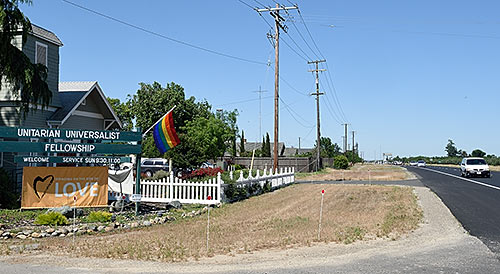
I admit to tangent taking here, a comparison of apples to oranges. Millions not flushed down the Baghdad donniker certainly wouldn’t have become magically available for transportation projects. But numbers are available, can be compared. Americans insensitive to the war’s hideous humanitarian costs might at least care that their pockets have been picked, and remember that pocket picking in meditations on failing infrastructure.
The war cost about 2.2 trillion dollars. Roughly twelve of every hundred Americans is a Californian. Figure, then, that twelve percent, or 264 billion of that 2.2 trillion got took from the Golden State.
Subway construction costs range all over the place: $65 million a mile in Madrid, $417 per mile in Stockholm, a whopping two billion a mile for the Second Avenue subway. I’ll pull an unabashedly unreliable number out of a hat in the air, say $500 million a mile in urban California.
California’s 264 billion on the Iraq War — an incurred debt now, a done deal, in accounts payable; a past tense disaster, like a full facial tattoo bought on a binge drunk — would have paid for 528 miles of metro. Split that with L.A., and these already committed dollars could have funded an increase in BART’s system size of … oh, gee whiz! … around 250 percent.
Here’s a map of the BART system grid:
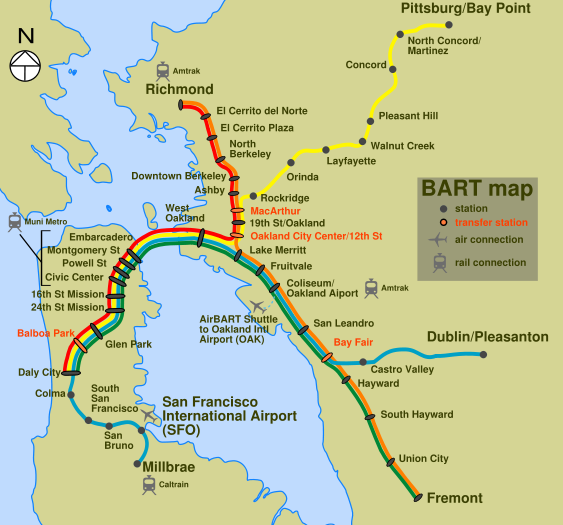
Make it grow 250 percent in that fertile imagination of yours. Remember, you’re not using new money. The Iraq War cheerleaders already spent it for you.
Do you think it might make your Bay Area commute a little easier?
* * * * *
1 Or have been; my visa came through yesterday.
Please wish me well in Spain. A related post may be premature; I ain’t there yet.
Two things.
1. Stockholm is cheaper than that! Citybanan is that expensive, but a newer set of subway (not commuter rail) extensions is less than half as expensive per unit length.
2. Urban California is more expensive than that. LA is building a subway for that cost figure, but the Central Subway is around twice as expensive. Even BART to San Jose is projected to cost more, even though the tunneling is in a not particularly dense area. The US just sucks at transit.
For both sets of figures, follow links from here.
For what it’s worth, California HSR has reasonable costs, modulo ridiculous alignment decisions (Pacheco, Tehachapis) and scope creep (Millbrae tunnel, San Jose iconic bridge).
More fundamentally… okay, you have an extra $2.2 trillion nationwide. It doesn’t all go to public transit, because the US has other spending priorities: poverty reduction, public housing, health care, education, electric grid, water supply, digital infrastructure, green energy, building insulation, Social Security, tax cuts. My sense is that, after or in tandem with a program to reduce construction costs, the US should commit $1 trillion, state and federal, to urban and regional (i.e. not intercity) transit in the next 20 years, but that’s way more than can be saved by just not starting another war, and this $1 trillion is used up fast by various competing priorities. The SF region’s share is charitably $25 billion, which (even at normal-world costs) buys you a second Transbay tube and a bunch of connections (Geary, Judah, a second line in Oakland, a branch across the Golden Gate, etc.), but nothing that turns San Francisco into Tokyo with better weather. A lot of that would require all those self-styled millionth-generation farmers to accept urban upzoning – to make it legal to build densely around stations, without much parking.
My first comment in about four years! Thank you for sharing.
(Note to other readers: Alon Levy is steward of the Pedestrians Observations blog — https://pedestrianobservations.wordpress.com/ — linked once in this post.)